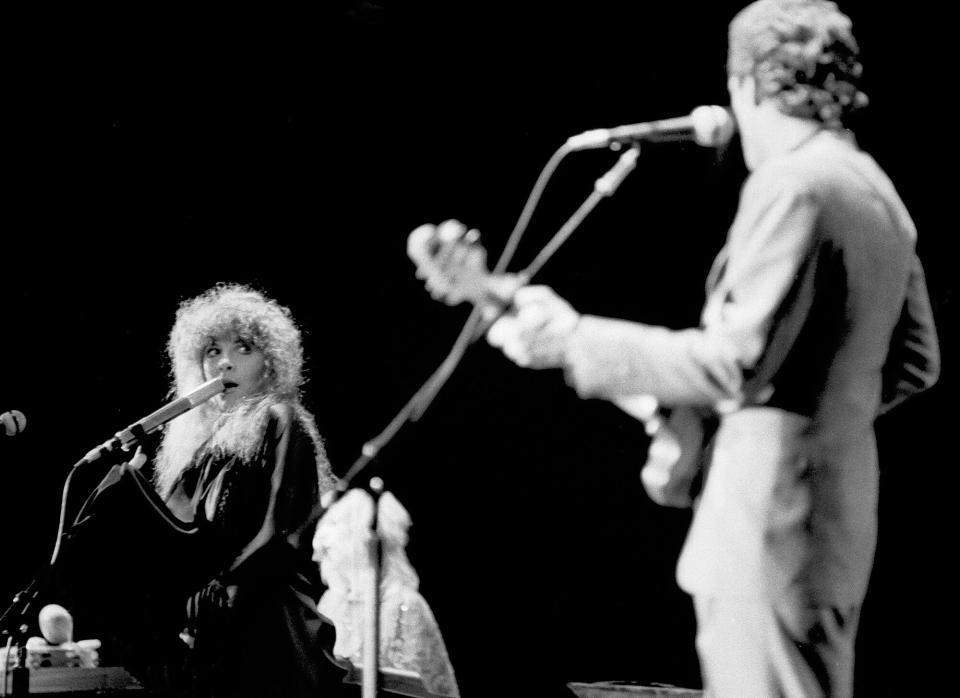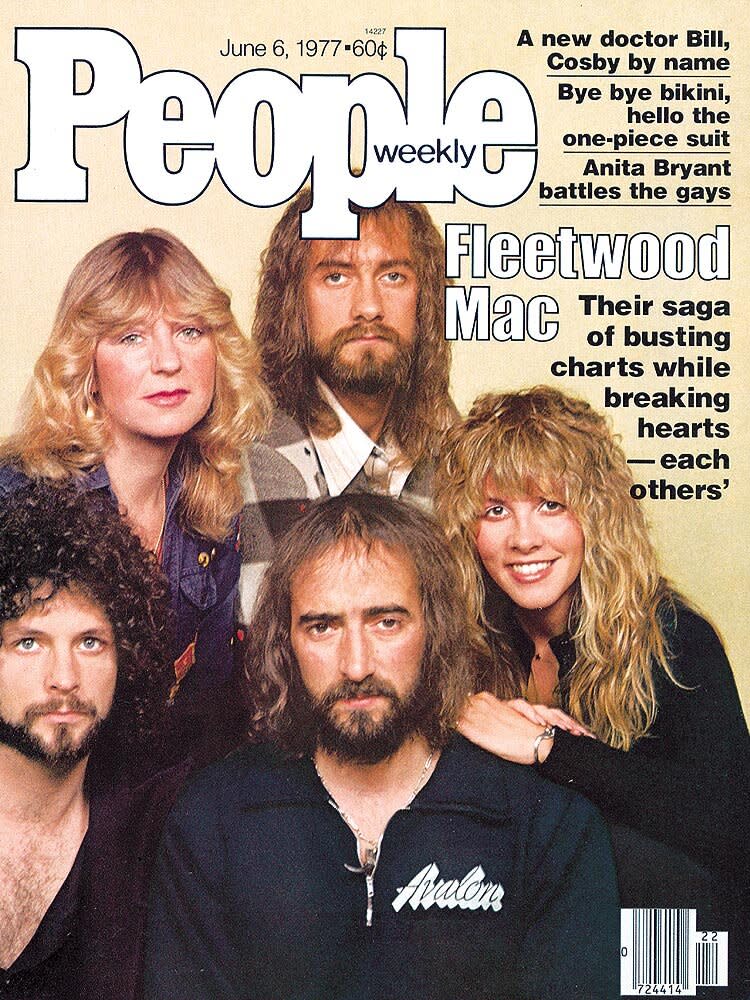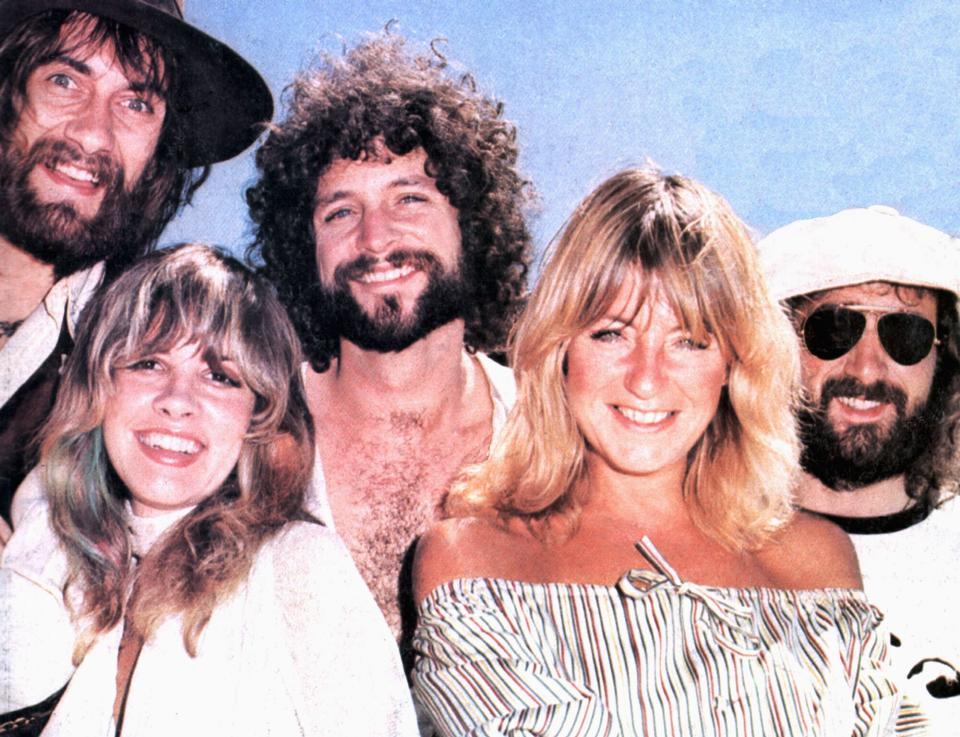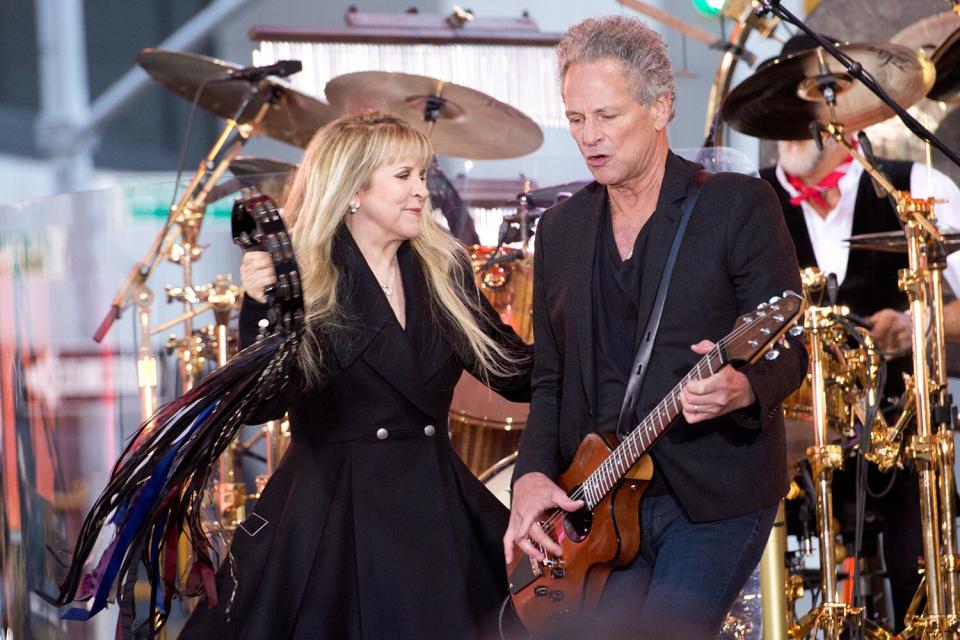Dashed 'Dreams' and Broken Hearts: Inside the Tumultuous Making of Fleetwood Mac's Rumours

- Oops!Something went wrong.Please try again later.
- Oops!Something went wrong.Please try again later.
- Oops!Something went wrong.Please try again later.
Michael Ochs Archives/Getty
On April 2, 1977, Fleetwood Mac were rewarded handsomely for channeling the most traumatic and grueling episode of their collective lives into a musical masterpiece.
On that day, their definitive album Rumours hit No. 1 on the Billboard album charts, kicking off a year in which they'd hold the top spot for 31 weeks, notch up four top 10 singles and eventually win the album of the year Grammy.
Of course, inconceivable success didn't put a pin in the chaos among the group members. Far from it. But the quintet's ability not just to survive their pain but to use it in a sort of sonic alchemy would be what sealed their legacy as one of the greatest rock bands of the 20th century.
"I think one day John and I will write a book on what's gone down," Fleetwood joked with The Los Angeles Times' Robert Hilburn in 1976, shortly before the album's release. "The only problem is that no one will believe us."
On the anniversary of the day Rumours began its reign atop the charts, we're looking back on how Mick Fleetwood, Christine and John McVie, Lindsey Buckingham and Stevie Nicks created one of music history's messiest and most magnificent albums.
THREE COUPLES IN 'SHAMBLES'
Fleetwood Mac went into the studio to record Rumours in February 1976.
The group's namesake drummer, Mick Fleetwood, was the first among them to take a personal hit when he discovered his wife and the mother of his children was engaged in an affair with his best friend, telling PEOPLE in 1977 that perhaps this first "split-up catalyzed the others in the band."
The McVies had also recently decided to separate after an eight-year marriage that began with a whirlwind courtship in which they'd gotten married less than six months after meeting one another. From there, they'd immediately started touring with Fleetwood Mac's frequently changing lineup.
The reality of the road and John's "more Hyde than Jekyll" personality while drinking eroded their union over time. Christine told Rolling Stone in 1977 that "the strain of me being in the same band as [John] started to take its toll. When you're in the same band as somebody, you're seeing them 24 hours a day and you start to see an awful lot of the bad side."
Simultaneously, Nicks and Buckingham — whose relationship had already been on its last legs when they joined Fleetwood and the McVies in 1975 — were finally officially calling it quits on their "volatile" relationship.
"When we joined Fleetwood Mac," Nicks told Billboard in 2014, "I said, 'OK, this is what we've been working for since 1968. And so Lindsey, you and I have to sew this relationship back up. We have too much to lose here.'"
Buckingham admitted to Blender in 2005 that he and Nicks "had to go through this elaborate exercise of denial, keeping our personal feelings in one corner of the room while trying to be professional in the other."

Michael Putland/Getty Stevie Nicks and Lindsey Buckingham
Unfortunately, the civility-for-art's-sake only lasted so long: "When we broke up, two years after joining Fleetwood Mac, it was like a living nightmare," Nicks told Australia's Woman's Own in 1990. "He and I were about as compatible as a boa constrictor and a rat."
Fleetwood told PEOPLE of returning to the studio to record the album that would become Rumours: "We were all in an emotional ditch. Everybody knew everything about everybody. But I was the piggy in the middle because I had less trauma than the others." (He expanded on the thought years later in Uncut: "At least I was spared the in-house, up-front situation. I didn't have to actually work with my ex-spouse.")
Still, Christine acknowledged to Rolling Stone in 1997, "Everybody was pretty weirded out. Somehow Mick was there, the figurehead: 'We must carry on … let's be mature about this, sort it out.' Somehow we waded through it."
And by all accounts, it was exactly that fraught dynamic that set the stage for greatness.
"Instead of going to friends to talk it out, their feelings were vented through their music," producer Richard Dashut told Modern Recording in 1979. "It created a certain sensitivity. Our personal lives were in shambles, and the album was about the only thing we had left."
SCREAM, SING, RIFF, REPEAT
The group left Los Angeles and headed up to the northern California oceanside town of Sausalito, hoping to find a creative haven. As the saying goes, we make plans and God laughs.
The band members didn't realize it at the time, but the recording of Rumours would ultimately span 11 months, including two months up north, a 10-day tour and a final recording jag back in L.A.
"Records like Rumours don't happen anymore," producer Ken Caillat told Music Radar in 2022. "We spent a year and a lot of hell working on it. Lives were changed, people changed, everything became different. Something like Rumours could never happen these days. A record label would have shut us down after two weeks."
From the minute they arrived, Christine told Rolling Stone, it was "trauma, trau-ma. The sessions were like a cocktail party every night — people everywhere."
While her ex was carousing away his loneliness, the women found solace in each other.
"That house was like the riot house," Nicks told Uncut in 2013. "There were girls everywhere and everybody was completely drunk the whole time. Me and Chris decided we couldn't be there. The next day we moved out and got two matching apartments next to each other."
She continued, "We didn't have anybody else .... the band gave me a friend in this woman, and I could hang out with Christine."
RELATED: Stevie Nicks Once Told Katy Perry Not to Have 'Rivals' After Her Own Pact with Christine McVie

Rick Diamond/Getty Christine McVie and Stevie Nicks
That's not to say that any of the bandmates were practicing clean living.
"The band would come in at 7 at night, have a big feast, party till 1 or 2 in the morning, and then when they were so whacked-out they couldn't do anything, they'd start recording," recalled Record Plant owner Chris Stone in a 1997 interview with Billboard.
While Nicks later told Blender that her serious cocaine addiction didn't set in until 1980, she did acknowledge that the toxicity and turbulence of the time set her on that trajectory. "It's so intense and so heavy, and being in Fleetwood Mac was like being in the Army," she said, per Uncut. "I was doing a lot of drugs just to get me through to the next thing." (She even wrote Rumours' closing song, "Gold Dust Woman," about her drug rituals, and Caillat later also told Music Radar that "Stevie had a lot of Courvoisier in her" while recording the feral track.)
'YOU'LL BE SUPERSTARS'
Adding to the pressure, their eponymous first album as a fivesome (which had been released in July 1975 and dubbed The White Album by the band) was climbing the charts.
Caillat told HuffPost in 2012 that the studio called the band and told them, "If you can make the current album as big of a hit as the White Album — you'll have two hits in a row and you'll be superstars."
Fleetwood told Mojo magazine in 2013 (per Albumism), "I didn't want someone that was going to mimic what we'd done before. That would have been hokey." Instead, they wanted to put together an all-killer, no-filler album in which every song could potentially be a single.
Caillat told HuffPost that it was "kind of extraordinary to be in the studio while an artist's album is doing really well. From that day on, things changed. Everyone in the band started to re-examine their roles. They decided that even though they were all trapped together in divorce mode, they were going to make it work and make the best of it."
Christine summed it up best (and most wryly), per Uncut: "The band was at the pinnacle of its career and we had a responsibility not to break that up for anything as trivial as a divorce."
Never miss a story — sign up for PEOPLE's free daily newsletter to stay up-to-date on the best of what PEOPLE has to offer, from juicy celebrity news to compelling human interest stories.

Bob Riha, Jr./Getty/Getty Stevie Nicks and Lindsey Buckingham
SHOTS FIRED
And though Buckingham would later call the recording experience "the most intense year of my life," it was also the time when he — still a self-proclaimed "new kid on the block" in the band — really came into his own.
"Lindsey had a grand plan in his head, and he got his way," Caillat told Music Radar. "This was the start of him really calling the shots. It became a my-way-or-the-highway thing with him."
He certainly had space to grow — according to Christine via Uncut, the McVies "were as cold as ice to each other" and "literally didn't talk, other than to say, 'What key is this song in?'" (John wasn't entirely wrong to give his ex the silent treatment considering she was writing "You Make Loving Fun" about her new lover, the band's lighting designer.)
A confessional, raw songwriting style was also developing for Nicks and Buckingham — though they were much more vocal in their discord.
"A lot of Lindsey's lyrics sparked fights with Stevie," Caillat told Music Radar. "I didn't know exactly what was happening at the time, but words were flying around, particularly Lindsey's, about their breakup. Stevie hated when Lindsey got even a little literal. The minute Lindsey would start singing his lyrics, Stevie stormed out and the session would end."
One lyric from Buckingham's "Go Your Own Way" particularly riled Nicks: "Tell me why / Everything turned around / Packing up / Shacking up is all you want to do."
"Every time those words [about "shacking up"] would come out ... I wanted to go over and kill him. He knew it, so he really pushed my buttons through that," she told Rolling Stone in 1997, adamantly insisting that Buckingham "knew it wasn't true. It was just an angry thing he said."
But even when there were no walk-outs, the mood was heated, shared Caillat.
"I remember when we were doing background vocals [on "You Make Loving Fun"], Stevie and Lindsey were having an argument. Vicious name-calling — 'you motherf---er' this, 'you f---ing bastard' that. Back and forth it went," he said. "The tape would start rolling and they'd sing, 'Yooooooou make loving fun,' just beautiful, two little angels. The tape would stop and they'd be calling each other names again. They didn't miss a beat."
TURNING A NIGHTMARE INTO 'DREAMS'
Out of that explosive dynamic came the band's biggest hit ever: Rumours' second track, "Dreams."
The song would go on to become Fleetwood Mac's only No. 1 single, but when Nicks composed it — in funk musician Sly Stone's bed, no less — "Dreams" was part of a set with "Go Your Own Way."
Nicks explained in the liner notes for Rumours' 2013 reissue: "Even though 'Go Your Own Way' was a little angry, it was also honest. So then I wrote 'Dreams,' and because I'm the chiffony chick who believes in fairies and angels, and Lindsey is a hardcore guy, it comes out differently. Lindsey is saying go ahead and date other men and go live your crappy life, and [I'm] singing about the rain washing you clean. We were coming at it from opposite angles, but we were really saying the same exact thing."
She continued the thought in The New Yorker in 2022: "It's really about our breakup. He's looking at it from a very unpleasant, angry way, and I'm saying, in my more airy-fairy way, we're gonna be all right. We'll get through this."
And, ironically, though Rolling Stone deemed Nicks' "nasal singing ... the only weak vocal on the record" in its original 1977 review (and even Christine initially deemed it "boring," per Blender), the song was clearly destined to strike a chord with listeners. "Dreams" became the quintessence of how the warring bandmates' ability to channel their agony into pitch-perfect harmony proved a winning formula.
"You can look at Rumours and say, 'Well, the album is bright and it's clean and it's sunny,' but everything underneath is so dark and murky," Buckingham told Uncut. "What was going on between us created a resonance that goes beyond the music itself. You had these dialogues shooting back and forth about what was going down between us and we were chronicling every nuance of it. We had to play the hand out and people found it riveting."
Added Buckingham, "The built-in drama cannot be underplayed as a springboard to that album's success."
Nicks echoed that sentiment in 2016's Fleetwood Mac on Fleetwood Mac: Interviews and Encounters: "If you took out all the bad stuff in the band, the songs wouldn't have happened. There simply wouldn't have been a Rumours if everything had been fabulous."
PUTTING IT ALL TOGETHER
Interpersonal drama aside, getting to the final cut wasn't free of technical issues either.
When the group decamped in a studio in a seedy section of Hollywood Boulevard for the final sprint, they discovered their nine weeks of recordings from Sausalito had been damaged by a machine they playfully nicknamed "Jaws." With panic setting in, they canceled a sold-out tour.
And the costly move was worth the sacrifice.
Not only did the begrudging do-over spur the creation of "The Chain" (the only Rumours track on which all five band members are listed as collaborators) because the band was forced to reconsider and rework many of their songs through a painstaking process of redubbing and splicing old recordings with new ones, it also forced them to finally step back and survey the as-yet-unnamed album in its entirety.
As they listened to the lineup of songs come together, John told Rolling Stone he couldn't help but be overcome. His response "was clumsy sometimes," he said in 1977. "I'm sitting there in the studio and I get a little lump in my throat — especially when you turn around and the writer's sitting right there."
Appropriately, John was the one who came up with the album's now-iconic name, inserting a little levity into the sublimely torturous experience.
He recognized that "we were all writing journals and diaries about each other," Christine told Uncut. "But we didn't quite realize that until all the songs were strung together. Then we knew we had something pretty powerful, to a point that transcended everybody's misery and depression. I think we knew that if we'd all been getting on like a house on fire, the songs wouldn't have been nearly as good."

A PHOENIX OF AN ALBUM
Rumours was released in the U.S. on Feb. 4, 1977 and was "shipped out in greater quantities than any other record in the history of Warner Bros," according to the 1977 Rolling Stone cover story.
It didn't hurt that the band posed for a quite literally cheeky Annie Leibovitz cover photo that played up the very complications and entanglements that had sparked the album's name. (Though it absolutely did not help that the hours-long naked photoshoot sowed the seeds for a brief but disastrous affair between Nicks and then-married Fleetwood that "caused a lot of pain for everybody," Nicks admitted to Oprah Winfrey in 2013, per HuffPost.)
RELATED: The Most Infamous Love Triangles in Rock History
The album hit No. 1 on April 2, and "Dreams" (which had been released as Rumours' second single in March) hit No. 1 on the Hot 100 in June. Without pause, the band embarked upon a seven-month-long American tour as their creation crested the charts on its way to becoming the highest-selling album of the year.
The money and acclaim were rolling in, but the emotional hangover of producing Rumours lingered in the immediate future and for a long while after.
"It still affects me," John McVie told Rolling Stone in 1977. "I'm still adjusting to the fact that it's not John and Chris anymore. It goes up and down."
Nicks and Buckingham even famously got into a fight on stage during the Rumours tour, which created ripples off stage. "I think [Buckingham]'s the only person I ever, ever slapped," Christine told Rolling Stone in 1997. "I actually might have chucked a glass of wine, too."
"We were really young," Nicks explained, per Yahoo. "People expected so much from us, and all of a sudden we went from barely having enough money to pay for a small apartment to being rich overnight."
She continued, "And how do you deal with that...? You kind of don't deal with it very well. And nobody dealt with it very well."
Buckingham told Rolling Stone in 1984, "When Rumours went crazy, I just couldn't bring myself to feel strongly about the album. At some point, all the stuff surrounding it started to become the main focus. There was a gap between what I felt was important internally — what I had accomplished musically — and the popular acclaim."
When Nicks looked back on the Rumours era for Oprah's Master Class in 2013 (per Express), she told Winfrey that it could be difficult when "you're in this band and guess who you have to see the next day ... and guess who you have to go on stage with tomorrow night? The person that either broke up with you or you broke up with and you have to go up on stage and just be fantastic."
"I used to go onstage and drink a bottle of Dom Perignon, and drink one offstage afterwards," Christine said, according to Uncut. "There was a lot of booze being drunk and there was blood floating around in the alcohol, which doesn't make for a stable environment."
Caillat has similarly mixed feelings, telling Grammy.com in 2014, "I spent at least 3,000 hours on it. I wish I could enjoy it like everybody else. But every time I listen to it I can remember every part, every issue, every fight, everything. So it's not as much fun for me."

GAB Archive/Redferns
RUMOURS' LEGACY
The album's numbers speak for themselves.
To date, it has sold more than 40 million copies, making it one of the top 10 highest-selling albums of all time. It's been Diamond-certified in the U.K., Canada and Australia, and its 20-time Platinum certification in America has one report doing the math that Rumours is owned by more than one in every six households in the U.S.
Even the album's 'forgotten' track — Nick's heart-rending "Silver Springs" — found justice when the group reconvened in 1997 to film and record their live album The Dance.
The tune was cut from Rumours at the last minute in favor of the more upbeat "I Don't Want to Know." Even though Nicks had also written that song, she was "devastated" to lose "Silver Springs" (which was, ironically, included as a B-side on the single for "Go Your Own Way").
"I never thought that 'Silver Springs' would ever be performed on stage, [or] would ever be heard of again. My beautiful song just disappeared," she told MTV in 1997 (per Rolling Stone). Then two decades later, The Dance revived the song — and earned the group another Grammy. "For it to come back around like this has really been, really special to me," Nicks said.
RELATED: Fleetwood Mac Stories You Need to Know, in Honor of 'Dreams' Re-Entering the Hot 100
But it's "Dreams" that continues to be the group's marquee tune, even among a hit-jammed catalog.
"Sometimes you can get tired of singing a certain song over and over again," Nicks told Blender in 2005, "but I have never gone onstage, either with Fleetwood Mac or in my solo shows, without singing 'Dreams.' I don't think I could."
The song found a surprise second wind in 2020, once again climbing to the top of the Billboard singles charts after it underscored a viral TikTok video of a man cruising around on his skateboard, sipping cranberry juice.
The deceptively simple, "good vibes only" ethos of the song's late-in-life resurgence, of course, belies the deep pain and complexity at its foundation. But that's been the beauty of Rumours for nearly five decades now — it managed to weave together joy and despair, struggle and harmony all in 11 exquisitely mixed tracks.
"Looking back, it's like listening to war stories," Fleetwood told Uncut. "But you have to remember there were people yelling in pain with their legs shot away. There's blood and guts and disagreements still to this day. But that's what makes it mean a s---."
Caillat told HuffPost in 2012, "I consider it one of those great American stories about people who are unwilling to give up. That was what really struck me about making Rumours. Their incredible commitment despite their own struggles."
Closer to the album's release, Buckingham was less sanguine, half-joking to Rolling Stone in 1977, "Being in this band really f---s up relationships with chicks."

Noam Galai/Getty Stevie Nicks and Lindsey Buckingham
"[The romance is] over. It doesn't mean the great feeling isn't there," Nicks told MTV in 2009.
"We write about each other, we have continually written about each other, and we'll probably keep writing about each other until we're dead," she said in Rolling Stone in 2014. "That's what we have always been to each other. Together, we have been through great success, great misunderstandings, a great musical connection."
"We're beauty and the beast," she added to MTV. "It means that the love is always there but we'll never be together, so that's even more romantic."

